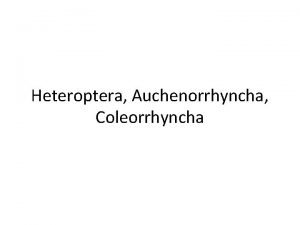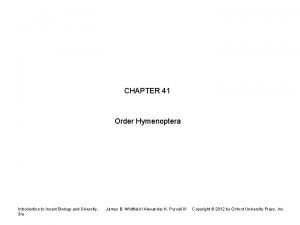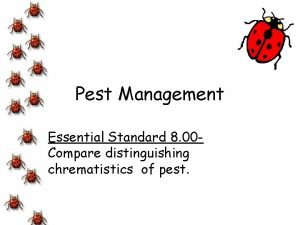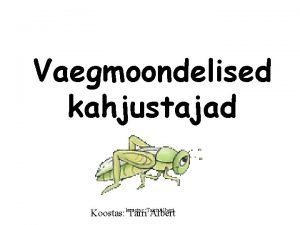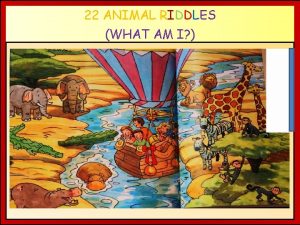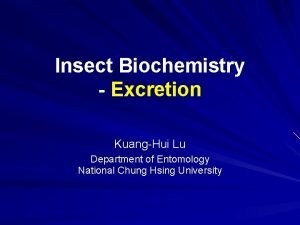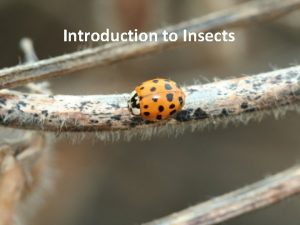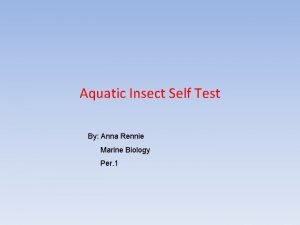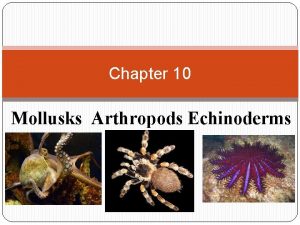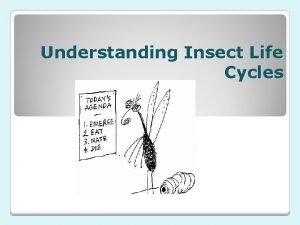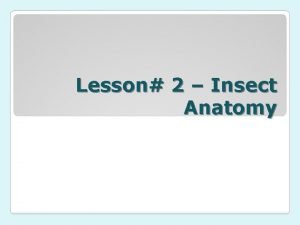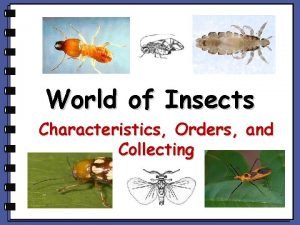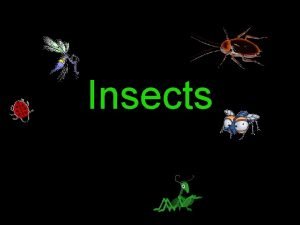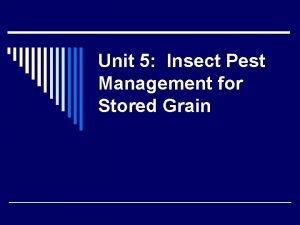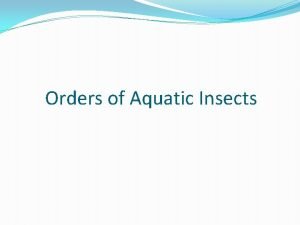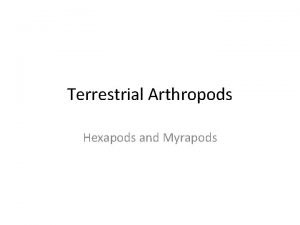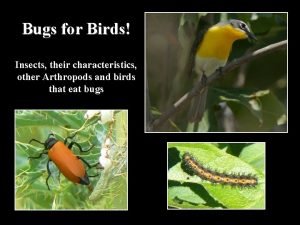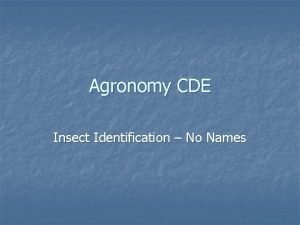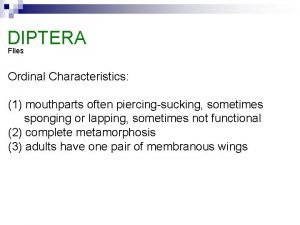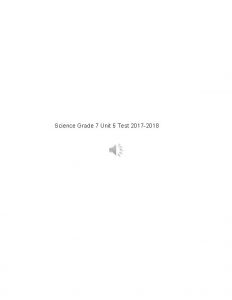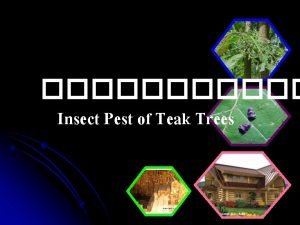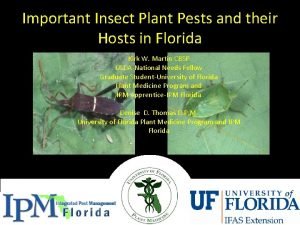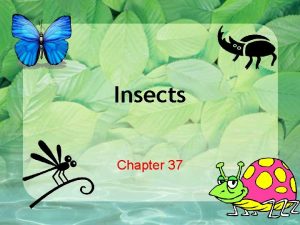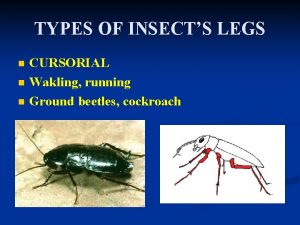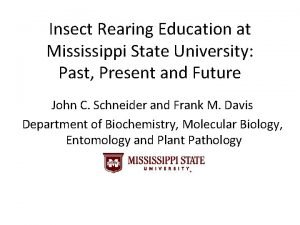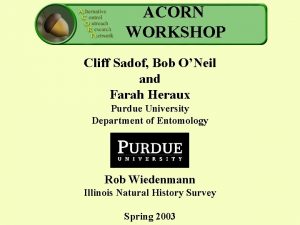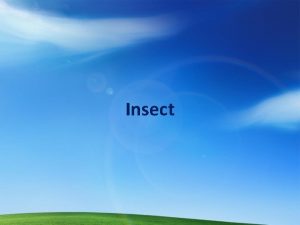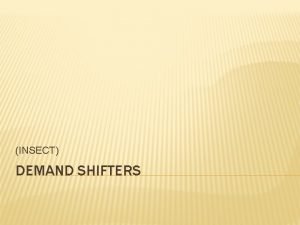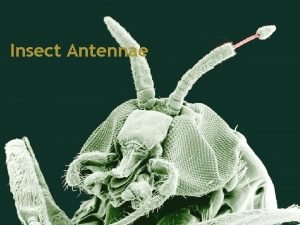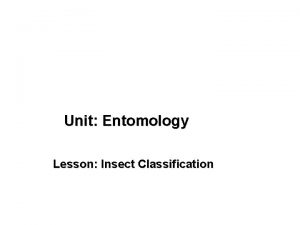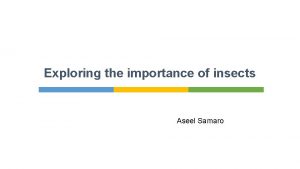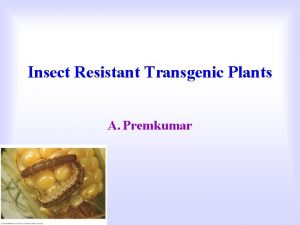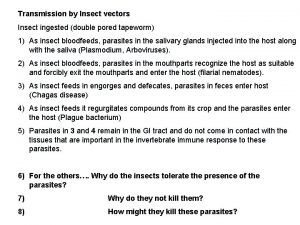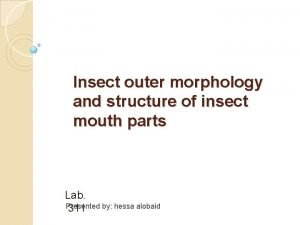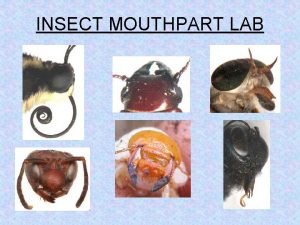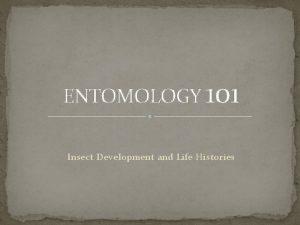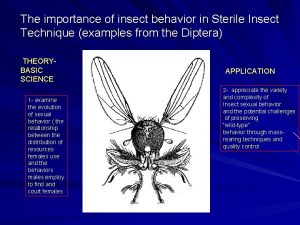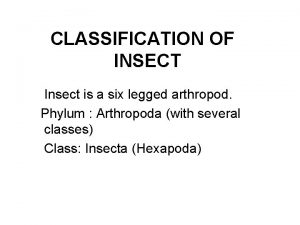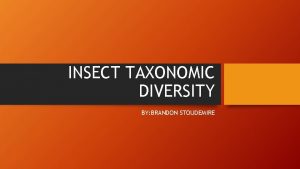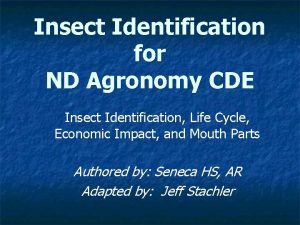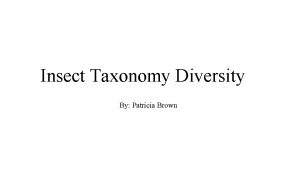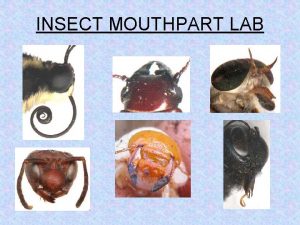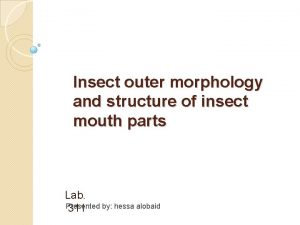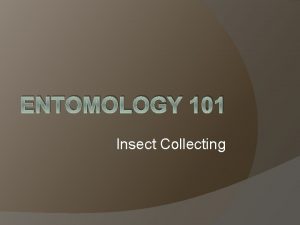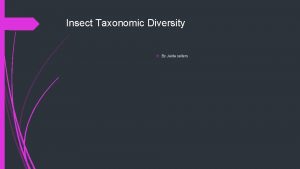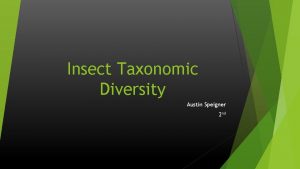Heteroptera Auchenorrhyncha Coleorrhyncha Paraneoptera 10 of insect species
















































- Slides: 48

Heteroptera, Auchenorrhyncha, Coleorrhyncha

Paraneoptera • ~10% of insect species (>120 k species) • Monophyly confirmed! denied(Johnson et al. , PNAS, 2018) • Chewing -> piercing mouthparts • Originally detritus > plant feeding -> predation -> plant feeding

Hemiptera • 97 k – 103 k known species • Small to large insects • Mostly terrestrial (x some Heteroptera) • Mostly herbivorous (x some Heteroptera) • Piercing-sucking mouthparts

Hemiptera • Monophyly suspected for a loooong time, confirmed severel times recently (Johnson et al. , PNAS, 2018; Li et al. , Proceedings B, 2017)

„Homoptera“ • Auchenorrhyncha + Sternorrhyncha (+ Coleorrhyncha? ? ? ) • First pair of wings not modified (x Heteroptera) • Opisthognathous head (x Heteroptera) • Herbivorous (x polyphagy in Heteroptera)

Hemiptera – main common feature • • • Piercing – sucking mouthparts 2 pairs of sclerotized mandibular and maxillary stylets Lying in 1 -5 segmented labium Food and salivary canals in-between maxillary stylets Cibarium - sucking pump


Sternorrhyncha • This is a story for another time…

Coleorrhyncha • Moss bugs • Moss feeding, slow moving • Gondwana distribution (Australia, NZ, New Caledonia, South America) • ~25 species in 12 genera, 1 extant family (Peloridiidae) • Small (2 -5 mm) • Opisthognathous head, posteroventral mouthparts, flightless (except one species), forewing held flat above abdomen when at rest, prothorax with paranota, small 3 -segmented antennae, hyaline tegmina

Coleorrhyncha • Relations to other Hemiptera = „The elephant in the room“ • Sister to Heteroptera (wing structure + musculature (btw PROBLEMS)) x Auchenorrhyncha (head structure + mouthparts position) • Sister to Auchenorrhyncha confirmed! • Head + base of wing similarity to Auchenorrhyncha

Auchenorrhyncha • ~42 k species (30 -40 families) (580 ČR) • Cosmopolitan • Small to large insects (mostly small) • Opisthognathous mouthparts (neck-beaks) • Short slender antennae • Wings entirely membranous (or leathery), folded roof like at rest • Species actively jumping (x Cicadidae) • Two primary groups • 1) Fulgoromorpha • 2) Cicadomorpha

Auchenorrhyncha • Tymbal organs for sound/vibration production • Universally used for mate finding • https: //www. youtube. com/watch? v=al 3 vr 3 Os. Csc

Auchenorrhyncha

Cicadomorpha • Cicadomorpha • Antenal pedicelus not larger than scapus • Filtrating chamber (xylem) • Nymphs not coated in wax • Fulgoromorpha • Pedicelus swollen, larger then scapus • Nymphs coated in wax

Cicadoidea ~3, 000 species 3 ocelli Larvae fossorial (modified front legs) • Mostly xylem sucking • • Cicadidae -> annual or periodical species (13 or 17) years cycles -> strongest songs -> cosmpolitan -> in ČR: Tibicina haematodes Cicadetta tibialis Cicadetta montana Cicadomorpha Tettigarctidae -> mostly extinct primitive cicadas

Cicadomorpha • Cercopoidea • ~2, 500 species (330 genera) • Hind tibia short, cylindrical with 1 -2 strong lateral spurs, and flared apical pecten • Xylem and phloem sucking • Nymphs sucking from plants and protecting themselves with „spits“

Cicadomorpha • Cercopoidea Cercopidae -> ~1, 360 species (4 in ČR) -> eyes circular from above, hind margin of pronotum straight or slightly curved -> nymphs in spits on plants Aphrophoridae -> ~990 species (5 in ČR) -> eyes rather oval from above, hind margin of pronotum W shaped -> nymphs in spits in ground

Cicadomorpha • Cercopoidea Macherotidae -> old world tropics (+ Australia) -> long spur from pronotum

Cicadomorpha • Membracoidea • > 24 k species • Hind tibia long, bearing row of mobile spines • Phloem or Xylem

Cicadomorpha • Membracoidea Membracidae -> ~3, 200 species -> pronotum enlarged (and by this I mean ENlarged)

Cicadomorpha • Membracoidea Cicadellidae -> >20 k species -> pronotum boring, I mean, not enlarged

Fulgoromorpha • > 12, 500 species (> 20 families) Delphacidae -> ~2 k species -> hind tibia with large movable spur Cixiidae -> ~2 k species

Fulgoromorpha Issidae -> ~ 1 k species Tettigometridae -> ~120 species Achilidae -> ~ 520 species Tropiduchidae -> ~600 species Dictyopharidae -> ~760 species

Fulgoromorpha Fulgoridae -> large > 1. 5 cm species -> no bioluminiscence though… -> head protrusions defensive? (at least native people are scared of them) Flatidae

Heteroptera ~40 k species (~900 in ČR) in !73! families Small to large insects Cosmopolitan Prognathous head Wings held over abdomen when at rest First pair of wings partly sclerotized (hemielytrae) Complex scent gland system (ventral in adults, dorsal in nymphs) • Terrestrial, semi-aquatic and aquatic (legs modification) • Phytophagous, predatory (legs modification), bloodsucking • •

Heteroptera

Heteroptera

Heteroptera

Heteroptera

Dipsocoromorpha • • ~300 species Small (0. 5 – 4 mm) Long hairy whip-like antennae On ground, in leaf litter Dipsocoridae -> 51 species (3 in central Europe -> 1 st and 2 nd antenal segment short, 3 rd and 4 th long, covered in hairs

Dipsocoromorpha Stemmocryptidae -> 1 species -> resembles Collembola -> described by Štys from PNG

Enicocephalomorpha • > 130 species • Small to medium (1 – 1. 7 mm) • Head transversally bilobated • Fore legs raptorial -> predators in leaf litter under stones, etc. • Mostly sub- and tropical, but reaching sub antarctic island (penguine and albatros nests)

Gerromorpha • ~ 1, 7 k species • Polyphagous, predators, scavengers • Solitery predators (Hydrometridae, Hebridae) x gregarious (Gerridae, Veliidae) • Conspicuously long and slender legs • Ventral part of body covered in fine hairs • Tarsal claws often before apex of tarsus • Living on water surface or near water, or on aquatic plants

Hydrometridae -> ~115 species -> long and slender -> head long cylindrical Gerromorpha Gerridae -> ~ 620 species -> head not longer than wide -> Halobates -> sea species

Gerromorpha

Gerromorpha Hebridae -> ~150 species -> 5 -segmented antennae Mesoveliidae -> ~40 species -> coxae of all legs almost touching Veliidae -> ~720 species -> hind femurs not overreaching the abdomen

Nepomorpha • ~ 2 k species • Mostly medium to large sized • Mostly predatory (leg modification) • Aquatic (breathing underwater modifications) • Antennae not visible from above

Nepidae -> ~250 species -> visible breathing siphon from abdomen Nepomorpha Belastomidae -> 14 species -> 2 retractable short respiratory filaments from abdomen -> parental care (M) Gelastocoridae -> 100 species -> riparian, eadges of water bodies -> leaping on their prey

Corixidae -> 500 species -> head looks opistognathous -> front tarsi short, hair-cover, used for finding prey in mud (palae) -> air beneath wing casis Nepomorpha Naucoridae -> 22 species -> like Belastomidae, but smaller -> active predators -> plastron Notonectidae -> 350 species -> back swimmers -> air trapped in fringes of abdonem

Leptopodomorpha • • ~380 species Very large eyes, almost whole side of head Semi- to fully aquatic Predatory Saldidae -> ~350 species -> ovoid in outline -> very agile, jumping

Cimicomorpha • ~21 k species • Forewing often with costal and medial fracture • Hindwing with developed subcosta, radius and media fused distally • Labium often joining head anteriorly • Lack of spermatheca • Predators, blood-suckers, herbivores

Cimicomorpha Polyctenidae -> 32 species -> blood-sucking on bats Cimicidae -> ~90 species -> wingless -> blood-sucking on mammals, specialization -> traumatic insemination Athocoridae -> 500 -600 species -> cuneus + ocelli -> predators

Cimicomorpha Nabidae -> >500 species -> predators, holding prey with fore legs -> soft body Reduviidae -> >7 k species -> predators, blood-sucking (Triatominae) -> narrow neck, sturdy build, thick rostrum -> their sting hurts, A LOT

Cimicomorpha Tingidae -> ~ 2 k species -> tiny, herbivorous -> wings and pronotum resemble laces Miridae -> >10 k species -> cuneus but no ocelli -> humped appearance -> herbivorous

Pentatomomorpha • >14 k species • Fore wing without costal fracture • Hind wing with radius and median not distally fused, subcosta not developed • Phytophagous (or Mycetophagous)

Pentatomomorpha Aradidae -> ~2 k species -> conspicuously flattened -> under bark, in leaf litter -> mycetophagous Termitaphididae -> 12 species -> extremely minute -> in termite nests Pyrrhocoridae -> 300 species -> no ocelli

Pentatomomorpha Lygaeidae -> ~4, 3 k species? -> ocelli Berytidae -> >50 species -> very long and slender legs -> some sap suckers, some feeding on mites and small insects (using legs in raptorial manner) Coreidae -> >1, 9 k species -> ocelli -> series of longitudinal accesory veins in membraneous part of forewing

Pentatomomorpha Pentatomidae -> 4, 7 k species -> 5 -segmented antennae -> very large scutellum Acanthosomatidae -> ~200 species -> less sclerotised -> tarsi 2 -segmented Scutelleridae -> 450 species -> scutellum over abdonem and wings
 Pentatomomorpha
Pentatomomorpha Keystone species in desert
Keystone species in desert Biology
Biology Insect name
Insect name Lecanium corni
Lecanium corni I am small i have feathers i lay eggs i can sing and fly
I am small i have feathers i lay eggs i can sing and fly Insect excretion
Insect excretion Arachnid body plan
Arachnid body plan Packaging
Packaging Oregon state insect
Oregon state insect Insect venom
Insect venom Odonata wings
Odonata wings Studying
Studying Echinoderms
Echinoderms Insect
Insect The life cycle undergone by insects
The life cycle undergone by insects Insect
Insect Grasshopper mouthparts
Grasshopper mouthparts Extemporaneous compounding
Extemporaneous compounding Characteristics of hymenoptera
Characteristics of hymenoptera Arthro drama
Arthro drama Insects three main body parts
Insects three main body parts Grain insect
Grain insect Maylfies
Maylfies Insect mouthparts
Insect mouthparts Characteristics of insects
Characteristics of insects Insect identification
Insect identification Diptera common name
Diptera common name Unit 5 science test 7th grade
Unit 5 science test 7th grade Insect resurgence
Insect resurgence Teak insect
Teak insect Animalia insects
Animalia insects Lepidoptera characteristics
Lepidoptera characteristics All spiders spin webs true or false
All spiders spin webs true or false Utah state rock
Utah state rock Insect egg
Insect egg Section 37-1 review the insect world
Section 37-1 review the insect world Cursorial legs
Cursorial legs Ms state insect
Ms state insect Insect bait
Insect bait Silly farah insect
Silly farah insect Insect foot
Insect foot Maxillae insects
Maxillae insects Insect dmg reduction
Insect dmg reduction Determinants of demand insect
Determinants of demand insect Pair of antennae
Pair of antennae Insect safety presentation
Insect safety presentation Classification of insects
Classification of insects Assel insekt
Assel insekt
